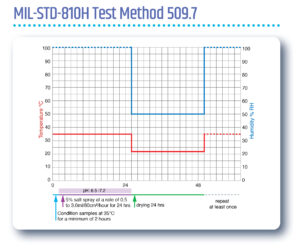The test standard summaries are for general guidance only. Though believed to be accurate at the time of writing, this may change over time. So this information should not be used as a substitute for referring to a complete test standard, at an appropriate revision level.
Note: the terms salt spray, salt mist and salt fog are all in wide spread use within corrosion test standards. In this context they can be considered to be equivalent and interchangeable terms.
MIL-STD-810G
Environmental engineering considerations & laboratory tests: Salt fog
This MIL standard has been revised and re-issued several times, with each issue being designated a new sequential suffix letter, which appears after the main standard number. With each revision the method number specific to this particular test may have changed, but the method itself is generally as follows:
Can be used to test the relative resistance to corrosion of coated and uncoated specimens, when exposed to a salt spray climate at an elevated temperature.
Test specimens are placed in an enclosed chamber and exposed to a continuous indirect spray of neutral (pH 6.5 to 7.2) salt water solution, which falls-out on to the specimens at a rate of 0.5 to 3.0ml/80cm²/hour, in a chamber temperature of +35C. This climate is generally maintained under constant steady state conditions, but may also be cycled between salt spray for 24 hours and ambient air drying for 24 hours. The test duration is variable.

Notes:
1. At least two hours of pre-conditioning are required at the test temperature before commencing the salt spray test.
2. Test samples need to be dried periodically at “standard ambient temperatures and a relative humidity of less than 50% for 24 hours, or as otherwise specified”.
Unless a fully automatic and multi-environment test chamber is utilised, the above requirements imply significant manual intervention during this test, including the use of supplementary controlled environment chambers.
For further information on US Dept of Defence MIL standards visit; www.nssn.org